Key takeaways:
- Sentencing alternatives, such as community service and restorative justice, offer opportunities for rehabilitation and reintegration into society instead of incarceration.
- The anti-death penalty movement highlights systemic inequalities and the risk of wrongful convictions within the justice system, advocating for humane alternatives.
- Historical perspectives on capital punishment have evolved, with Enlightenment thinkers challenging its effectiveness as a deterrent and promoting reform over retribution.
- Advocacy for sentencing alternatives emphasizes the importance of personal narratives and community engagement to shift public perceptions toward a more compassionate justice system.
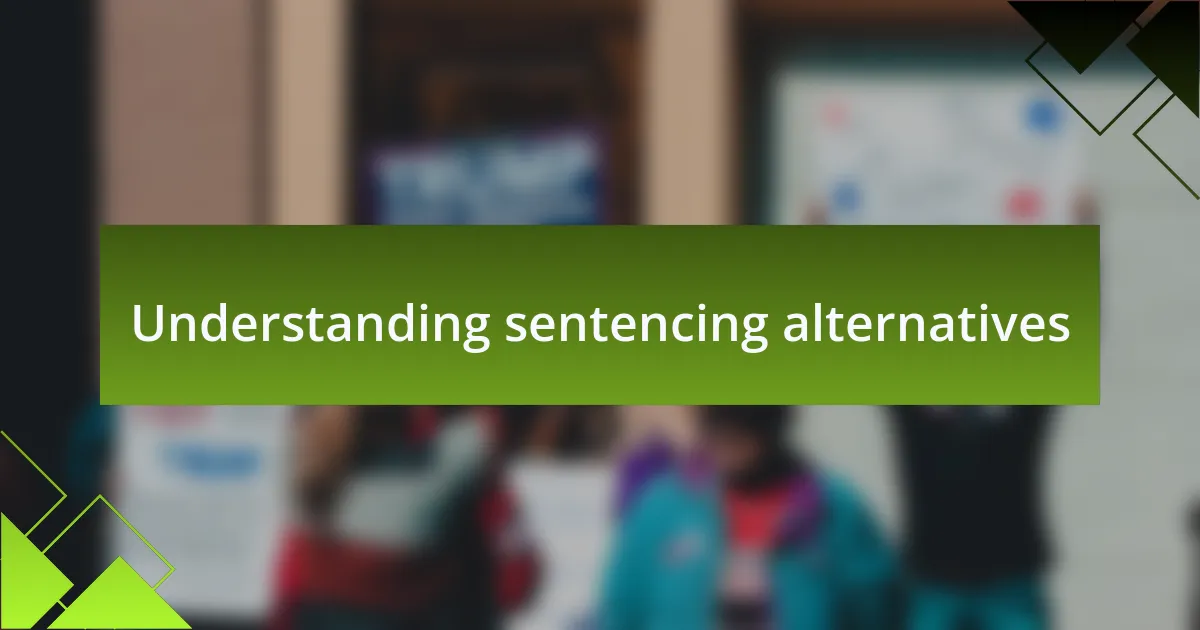
Understanding sentencing alternatives
Sentencing alternatives refer to various options that allow judges to impose penalties other than traditional incarceration or the death penalty. Reflecting on a case I once researched, a young man was given community service and probation instead of jail time for a non-violent crime. This made me wonder: how often do we consider the impact of giving someone a second chance rather than labeling them as a criminal for life?
One important aspect of sentencing alternatives is restorative justice, an approach that focuses on repairing the harm caused by crime through reconciliation between victims and offenders. I recall a powerful story where a victim met with her assailant in a facilitated session, which ultimately led to healing for both parties. Isn’t it fascinating to think that instead of just punishment, we could promote healing and understanding?
Another alternative is rehabilitation programs that address issues like substance abuse or mental health problems. I’ve seen firsthand how effective these programs can be; they not only help individuals turn their lives around but also contribute to safer communities. It leads me to ask: is it time we reevaluate our definitions of justice and focus more on healing rather than mere punishment?
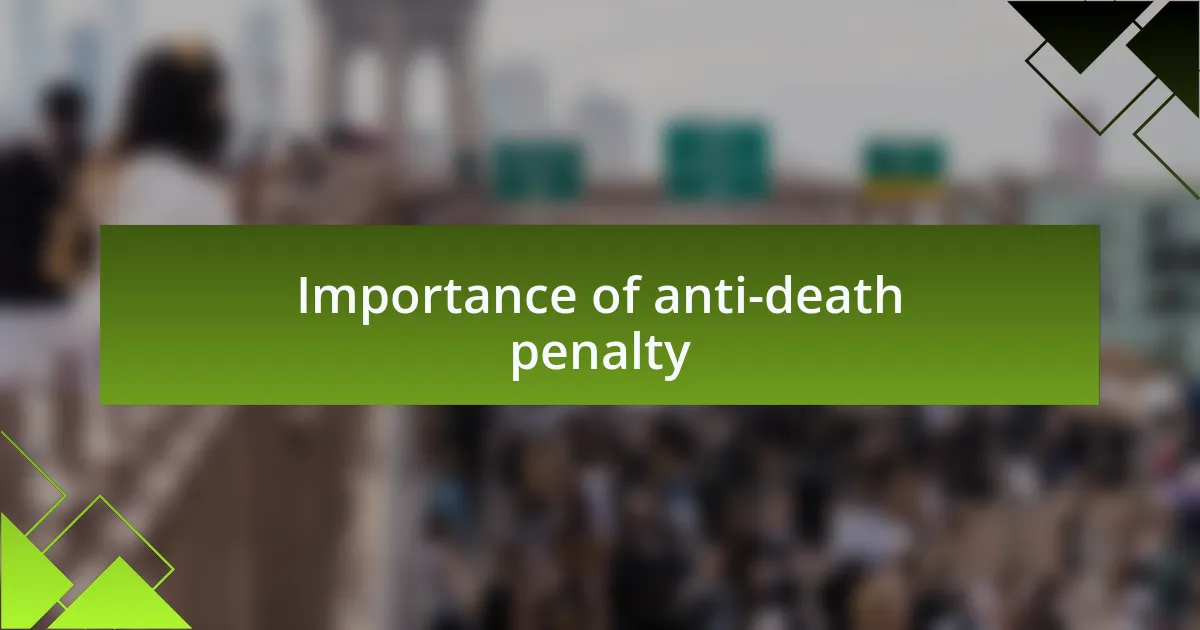
Importance of anti-death penalty
The importance of the anti-death penalty movement cannot be overstated. Personally, I’ve encountered many stories of wrongful convictions where innocent lives were nearly lost to an irreversible sentence. Each of these cases reflects a profound truth: the justice system is not infallible, and the stakes are tragically high when it comes to executing the wrong person.
Moreover, the death penalty often disproportionately affects marginalized communities. I remember a sobering conversation with a friend who works in social justice; he shared statistics highlighting how individuals from low-income backgrounds often lack the resources for adequate legal representation. Doesn’t it make you wonder how many lives have been impacted not just by their actions, but by systemic inequalities in the justice system?
Beyond the ethical implications, abolishing the death penalty raises critical questions about public safety and crime deterrence. In my experience attending community forums on this issue, many individuals expressed the belief that life sentences without parole can serve as a more humane and effective solution. Shouldn’t our focus be on creating a system that promotes rehabilitation rather than one that clings to outdated methods of punishment?

Historical context of capital punishment
The history of capital punishment stretches back thousands of years, with records of executions dating to ancient civilizations like Babylon. I often find it intriguing how these early societies viewed the death penalty as a fundamental aspect of justice, often believing that it was a necessary deterrent against grave offenses. Can you imagine living in a time when such finality was handed out as a remedy for societal wrongs?
During the Enlightenment in the 18th century, philosophical debates began to shape a new perspective on punishment. Figures like Cesare Beccaria argued passionately against capital punishment, highlighting its failures as a deterrent and bringing forth the idea that reforming offenders could lead to a more civilized society. Reflecting on this, it strikes me that these early advocates paved the way for contemporary movements, much like the conversations I engage in today about the importance of humane alternatives.
As the 20th century unfolded, many countries began to reevaluate their stance on capital punishment, influenced by a growing awareness of human rights. I remember reading about the abolishment movements that gained momentum, often spearheaded by individuals who had witnessed the profound personal losses inflicted by the death penalty. Isn’t it profound how societal values can evolve, urging us to seek compassion over retribution?

Overview of sentencing alternatives
Sentencing alternatives have emerged as crucial components of modern justice systems, providing options that prioritize rehabilitation over retribution. I often think about my conversations with friends who work in criminal justice. They highlight how these alternatives, like probation, community service, and restitution, can genuinely give offenders a chance to reintegrate into society, rather than being trapped by the stigma of a death sentence.
Probation, for instance, offers offenders the opportunity to serve their sentence while remaining in the community under strict supervision. When I hear stories of individuals who have turned their lives around because they were given this chance, it reinforces my belief that accountability can coexist with compassion. How inspiring is it to witness someone become a productive member of society after having committed a crime, especially when they were given resources and guidance instead of the finality of death?
Furthermore, restorative justice programs are gaining traction, focusing on repairing the harm caused by crime through dialogue between the victim and the offender. I recall a powerful event I attended, where a victim and an offender shared their stories, illustrating how healing is possible when people can confront their pain directly. Isn’t it remarkable that such initiatives not only promote healing but also contribute to a deeper understanding of crime’s impact? Engaging in these discussions about alternatives challenges us to rethink justice and our collective responsibility for change.
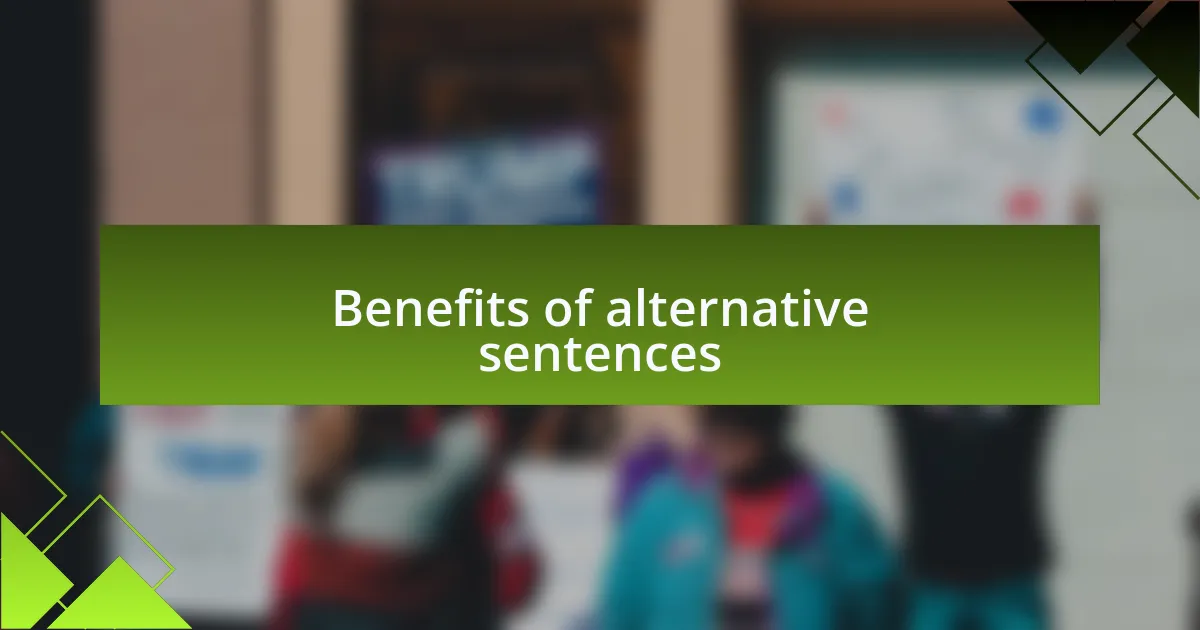
Benefits of alternative sentences
Alternative sentences offer significant psychological benefits for both offenders and victims. I remember a case study I read about a young man who received community service instead of prison time. Witnessing him connect with his community and engage in meaningful work was an eye-opener, emphasizing how second chances can foster accountability and motivate individuals to redirect their lives toward positive contributions.
Moreover, these alternatives often reduce the burden on the prison system. It struck me when I learned that overcrowded prisons aren’t just detrimental for offenders—they can also create dangerous environments for staff and inmates alike. By utilizing options like electronic monitoring, we can effectively alleviate some of that pressure, ensuring that the justice system focuses on rehabilitation rather than punishment solely for the sake of punishment.
Finally, alternative sentences can foster a sense of justice among victims and their families, as they can actively participate in the reconciliation process. I often ponder how empowering it must feel for victims to share their narratives in restorative justice circles. Isn’t it profound that such dialogues can create understanding and closure, transforming pain into pathways for healing instead of leaving wounds open and festering?
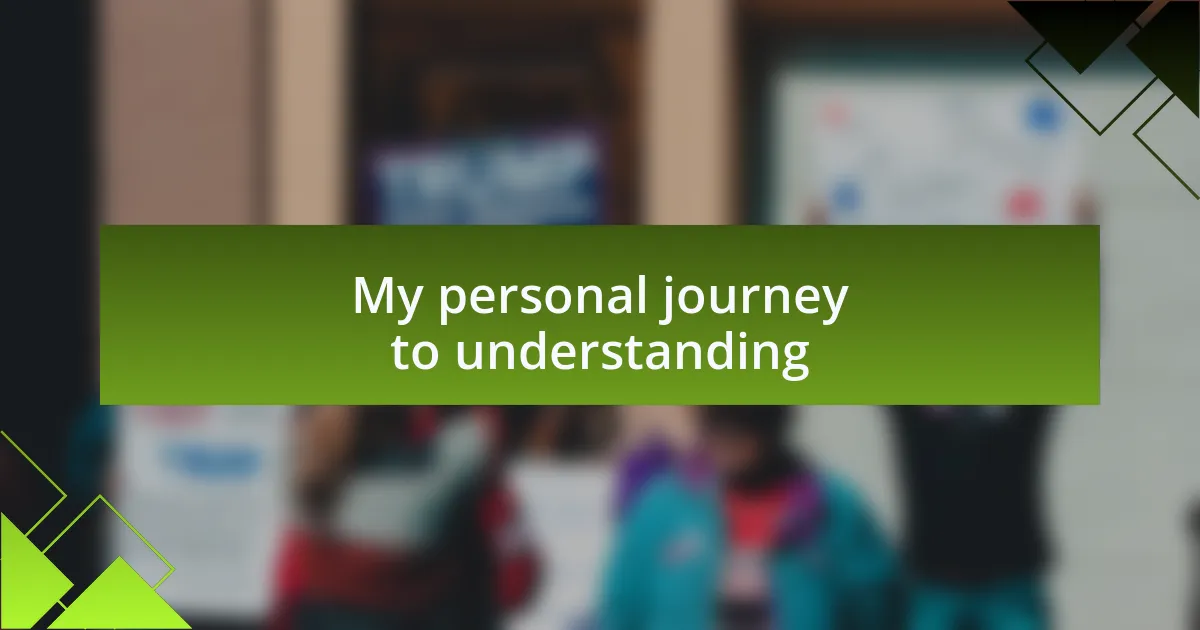
My personal journey to understanding
As I navigated my path to understanding alternative sentences, I vividly recall a powerful conversation I had with a former offender. He shared how community service shifted his perspective, transforming feelings of shame into a sense of purpose. Listening to his story, I began to appreciate how these alternatives can cultivate personal responsibility, awakening a newfound desire to make amends. Can you imagine the weight lifted off someone’s shoulders when they realize they can contribute positively to society instead of remaining defined by their past mistakes?
My exploration also led me to a local restorative justice program, where I witnessed firsthand the emotional rebuilding between victims and offenders. During one session, a victim spoke about her trauma while the offender listened, visibly moved. This moment made me question the traditional punitive approach: how can we truly heal when dialogue is stifled? It was profoundly eye-opening to see how such exchanges could plant the seeds for forgiveness and understanding.
Finally, as I delved deeper into these alternatives, I reflected on my own biases and preconceived notions about justice. I recalled a time when I instinctively felt that harsh penalties equated to justice. But gradually, I started to understand that real justice can also be about healing and redemption. Isn’t it incredible how our perspectives can shift when we allow ourselves to see beyond the surface? This journey has compelled me to become a more empathetic advocate for a justice system that values healing over punishment.
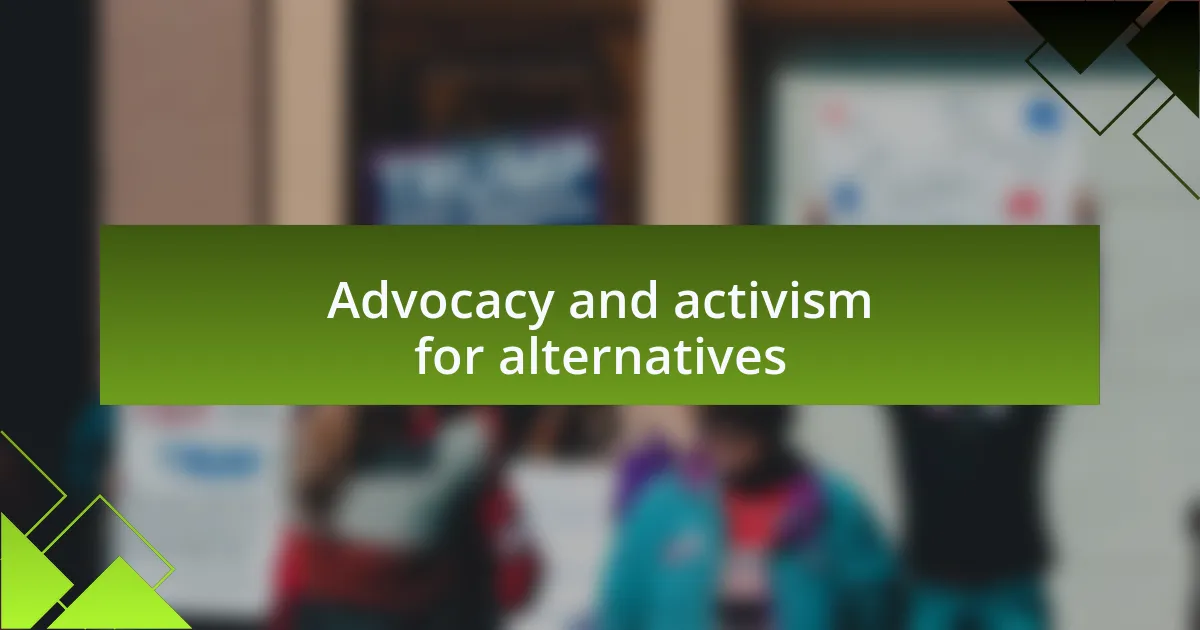
Advocacy and activism for alternatives
Advocacy for sentencing alternatives requires a concerted effort to shift public perceptions. I remember attending a community meeting led by activists who spoke passionately about the potential for restorative practices. Hearing their compelling stories, I found myself pondering: what if society focused more on healing rather than retribution? This possibility opened my eyes to a broader understanding of justice—one that prioritizes rehabilitation.
During my journey, I also had the opportunity to volunteer with a nonprofit that advocated for policy changes in sentencing. I engaged with individuals who had been directly affected by harsh penalties; their experiences were profound. It was heartbreaking to hear how long prison sentences often lead to more suffering—both for the offender and their families—rather than the intended justice. It made me realize how crucial it is for advocates to share these narratives, highlighting the human impact behind the statistics.
Through grassroots activism, I witnessed the power of collective voices in pushing for change. I participated in rallies where we passionately called for alternatives to the death penalty, which resonated deeply with me. The camaraderie felt among supporters was electrifying, and it left me wondering: how much stronger could our efforts become if more people recognized the value of these alternatives? Each person’s story is a step toward building a more compassionate system.